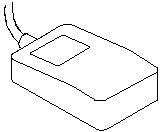|
MOUSE A hand-held device for moving a computer cursor and entering simple information. More Detailed Definition:
A device that controls the movement of the cursor or pointer on a display screen. A mouse is a small object you can roll along a hard, flat surface. Its name is derived from its shape, which looks a bit like a mouse, its connecting wire that one can imagine to be the mouse's tail, and the fact that one must make it scurry along a surface. As you move the mouse, the pointer on the display screen moves in the same direction. Mice contain at least one button and sometimes as many as three, which have different functions depending on what program is running. Some newer mice also include a scroll wheel for scrolling through long documents. Invented by Douglas Engelbart of Stanford Research Center in 1963,
and pioneered by Xerox in the 1970s, the mouse is one of the great
breakthroughs in computer ergonomics because it frees the user to
a large extent from using the keyboard. In particular, the mouse
is important for graphical user interfaces because you can simply
point to options and objects and click a mouse button. Such
applications are often called point-and-click programs. The mouse
is also useful for graphics programs that allow you to draw
pictures by using the mouse like a pen, pencil, or paintbrush.
Mice connect to PCs in one of several ways:
|
